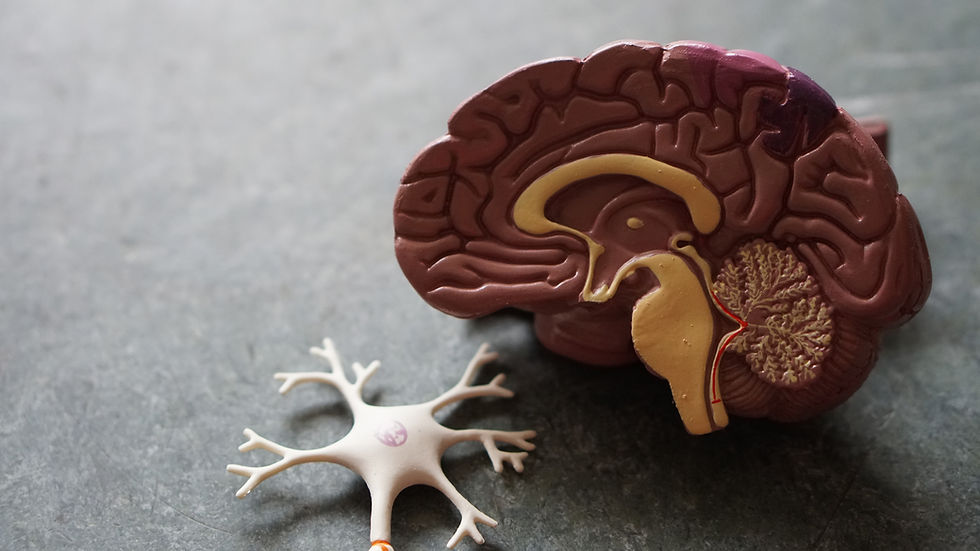Aphasia: Let's talk symptoms and therapy
- Laura Warburton
- May 1, 2023
- 3 min read

Aphasia and how it presents:
Aphasia is a brain disorder that makes it difficult for an individual to speak, or understand the words other people speaking that manifests due to a primary diagnosis. It can happen when there is damage or disruptions in parts of the brain that control spoken language. It does not, however, affect an individual's level of intelligence. Aphasia can be mild or severe, depending on the underlying cause and the degree of brain damage that exists. It can be caused by a stroke, brain injury, slow-growing brain tumor, or other neurological conditions. Aphasia can also be present at birth or develop over time due to aging or illness.
One category of Aphasia is known as fluent or receptive, in which case a person could experience poor comprehension and their use words that may lack meaning. Another category of Aphasia is known as non-fluent or non-receptive, where an individual can have good comprehension but difficulty finding the right words. Additionally, dementia is the cause behind what is known as Primary Progressive Aphasia, and the loss of language is the first symptom to arise in this case.
Approximately one million people in the United States have Aphasia, and there are an estimated 80, 000 new cases diagnosed each year. About one-third of stroke survivors suffer from Aphasia.
Whole Body Photobiomodulation (WBPM):
Whole Body Photobiomodulation (Red Light Therapy) is a therapy that is used for all areas of the body. Here at The Wellness Center, we use 4 different wavelengths of Light, (640nm, 810nm, 850nm, and 940nm) to target your entire body. WBPM can be used to treat a wide range of medical issues including skin conditions, muscle pain, joint inflammation, mental health disorders, and neurodegenerative disorders.
How Photobiomodulation can contribute to ALLEVIATING Symptoms of Aphasia:
The Wellness Center has medical-grade pods with protocols in place that target aphasia at a cellular level. A study posted on the 30th of March, 2023 states, "After the first 5-month series, this Person With Aphasia had utilized a slow rate of speech with a production of ∼25 to 30 words-per-minute during conversations and spontaneous speech. Utterance length was only 4–6 words with simple, grammatical structure. After the second, 5-month series of treatment combining PBM plus speech-language therapy, the rate of speech increased to 80+ words-per-minute and utterance length was increased to 9–10 words, with more complex grammatical structure."
Symptoms of Aphasia vary depending on the severity of the condition and may include:
Difficulty speaking.
Difficulty understanding speech.
Reading and writing difficulties.
Make using numbers difficult.
People with aphasia may also have difficulty with social communication and problem-solving skills.
Traditional Therapies for Aphasia:
Speech-Language Pathologists (SLPs) use a variety of techniques to help people with Aphasia regain their ability to communicate effectively. These therapies include speech and language therapy, cognitive-communication therapy, and alternative communication strategies such as sign language or picture boards.
The addition of WBPM as a complementary therapy has been shown to be effective in caring for those who suffer from Aphasia and appears to improve results. There are also support groups and online resources available for those living with Aphasia and their families. With the right help and support, those who contend with Aphasia can find new ways to communicate and lead fulfilling lives.
What families can do to support loved ones with Aphasia:
Be patient and give them plenty of time to respond
Speak with the person, not for them
Use short, easy-to-understand sentences
Communicate in a place that is quiet to limit distractions
Take your time when speaking
Use pen and paper, or a tablet to communicate
Photobiomodulation is a relatively new field of medical science (60 years), and it appears to be a viable option for those seeking adjunctive therapy to improve their quality of life. It’s a noninvasive, painless, promising therapy that uses light therapy to help reduce inflammation, improve healing. Studies have already demonstrated the effectiveness of this therapeutic technology for conditions like chronic pain, arthritis, and other musculoskeletal disorders. While studies are ongoing, Photobiomodulation appears to be a safe and effective method for promoting recovery from injuries or diseases.
A.J. Harewood
Contact The Wellness Center today to explore your options to start feeling better! We’re here to help!
Visit our YouTube Channel to view our Podcast on this and many other helpful topics today!
The information contained in this article, and information curated from third-party links are for informational purposes only and should not be used or interpreted as diagnosis or medial advice. It is your sole responsibility to consult with your medical doctor regarding any therapy plans or complementary care you might be considering for your personal medical care.
Additional Sources:
National Aphasia Association https://www.youtube.com/watch?v=zjkgSCIXo3k
.png)
Comments